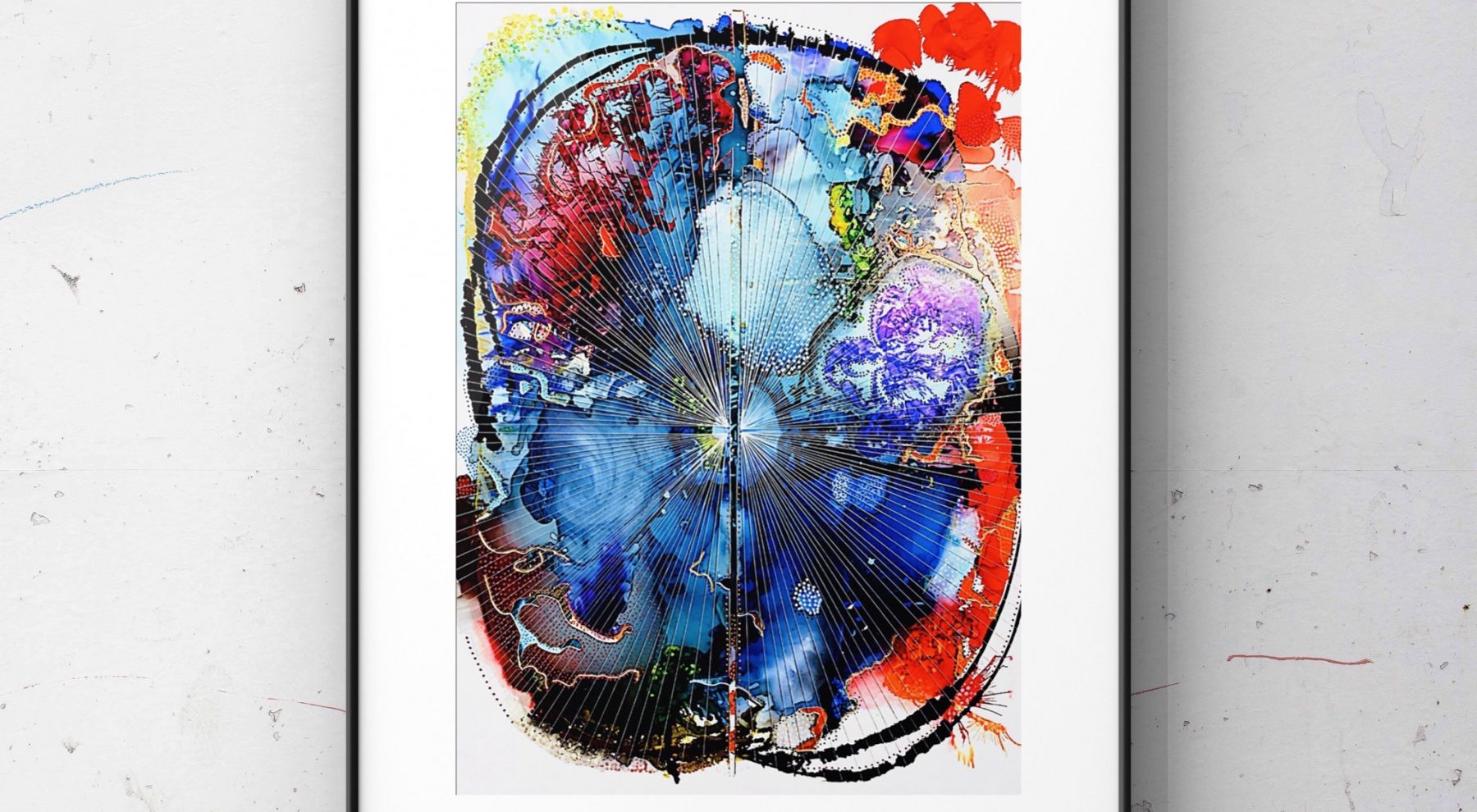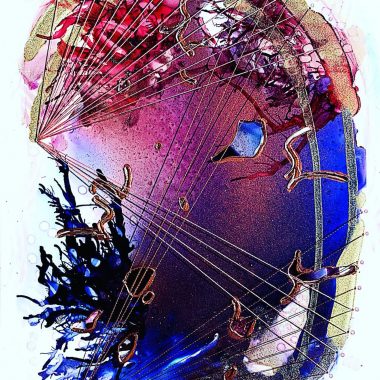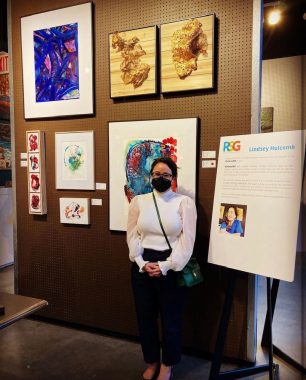Artist With MS Finds Beauty, Individuality in MRI Brain Scans
Mixed-media artist has completed, sold 198 re-interpreted versions of brain scans in 13 countries since 2019
Written by |

Lindsey Holcomb's artistic interpretation of her own brain MRI. (Photo courtesy of Lindsey Holcomb)
Reviewing an MRI of one’s brain and seeing lesions on it is a frightening prospect for people with multiple sclerosis (MS).
“The lesions, the bright spots on a brain scan, that’s probably the last place in your body most of us want to see things. [It’s] such an important organ,” said Lindsey Holcomb, a full-time, professional mixed-media artist who was diagnosed with relapsing-remitting MS in 2017. “And it was jarring. It brought up a lot of grief … and fear for me and fear of the unknown.”

Lindsey Holcomb started the Colors of MS social art project in early 2019. (Photos courtesy of Lindsey Holcomb)
But for Holcomb, 39, they were also a source of artistic inspiration, especially the MRI results that confirmed her diagnosis. She printed the black-and-white brain scan from her online medical chart and redrew it the way she saw it, hoping to make it more meaningful and representative of her personality.
“It was about as close as I could say like writing a diary entry is for an artist. That’s all it was. That was all it was supposed to be,” Holcomb, who lives in Portland, Oregon, told Multiple Sclerosis News Today.
She posted that image on social media and the National MS Society shared it. The positive response that followed led to the Colors of MS, a social art project that has transformed Holcomb’s passion into a business.
Since early 2019, Holcomb has completed and sold 198 re-interpreted versions of brain scans of MS patients in 13 countries. About half of her customers have allowed Holcomb to tell their MS diagnosis stories alongside their painting on her Instagram page.
Each painting varies, though Holcomb mainly uses ink drops, acrylic and oil paint, and thread to create her mixed-media 2D masterpieces. She uses a wood-burning tool to cut out brain structures and lesions, clearly stating they are not anatomically accurate.
Holcomb finds inspiration from her Japanese heritage with the practice of Kintsugi, in which pottery is broken and the points of reattachment are highlighted, typically with gold. She also honors her grandmother, who was a seamstress, attaching her leftover thread to different parts of a painting.
Prices for the artwork range from $375 for a 9-by-12-inch piece and $500 for an 11-by-14-inch one, to $1,200 for a 26-by-20-inch version. Each takes from a week to a month to complete, depending on the size and drying times.

In this Colors of MS piece, brain structures near the frame’s edge and lesions (circular areas in the center) are represented artistically using a wood-burning tool and gold paint.
She connects with MS patients on social media, often messaging them cold. They typically are receptive to her, Holcomb said, but it takes a long conversation with each person prior to starting work, sometimes over the course of a year. Eventually, they send the scan, whether it be on disk, in an email, or a physical printout.
Holcomb then completes the piece and sends the original to the patient. Each usually has an emotional reaction to the artistic interpretation given their brain scan, she said.
“Just the colors and the brightness and making it seem like something so much less scary,” Patrycia Rzechowka said of Holcomb’s rendering of her own scan in the 2019 documentary, MS’ed With the Wrong Girl. “It’s symbolic of the fact that I have taken having MS and tried to turn it into something positive and something beautiful.”
Holcomb wasn’t always a full-time artist. It was more of a hobby and what she called a “sanity parachute” during a stressful time in her life — when she was raising two toddlers born 21 months apart and working as an executive assistant at a large corporation. She began the slow transition to her current vocation in 2018.
She was invited recently to become a member artist at The Rental Sales Gallery, part of the Portland Art Museum and representing artists across the Pacific Northwest. Membership means Holcomb’s work will feature occasionally in gallery shows. At the Catherine Bede Gallery in a Portland suburb, she is a resident artist and her original paintings are always displayed.
Holcomb’s own MS diagnostic odyssey started in high school. There, she recalls making fun of herself and her “superpower … ability to fall over when I was standing.” She had other symptoms that came and went, including tremors in her hands and muscle weakness.
After spending most of her undergraduate career at the University of Oregon, she moved to Japan to complete her majors in Japanese and Asian studies at Waseda University in Tokyo. Following graduation, she spent a year teaching English in the country.
Living there dramatically altered her way of life, Holcomb said. She began her first corporate job, which she found stressful. She believes those life changes masked her MS symptoms for a long time, and remembers them abating during her back-to-back pregnancies.

Holcomb poses in front of her art at The Rental Sales Gallery in Portland.
But those symptoms returned when her daughters were 3 and 4 years old. While reading them bedtime stories, she began to notice difficulties articulating words on the page. She also was diagnosed with optic neuritis, commonly associated with MS.
But it was the cognitive issues that pushed her to seek referrals to the neurologists who ultimately confirmed she had RRMS.
That led to the discovery of other medical issues, including more aggressive epilepsy that started in 2018, and Ehlers-Danlos syndrome, which she was diagnosed with in 2019. That disorder affects connective tissues that provide structure to joints, skin, blood vessels, and other tissues and organs.
Holcomb said her most difficult symptoms are joint pain, hypermobility, and fatigue, though it’s hard to differentiate the MS symptoms from those related to other disorders.
Holcomb is planning to expand her MS-related art. She is nearly one month away from donating a collaborative art project to the Providence Brain and Spine Institute in Portland, she said, that was funded by a grant from the Portland Regional Arts and Culture Council and The Awesome Foundation. For that piece, she circulated a template of a brain scan in the MS community and asked individuals to color, paint, or draw it however they saw fit. The 36 returned templates are being pieced together for the project.
She also hopes to spruce up hospital and clinic waiting rooms. Holcomb still remembers seeing an insipid painting of birds in a basket and magazines with titles like “20 Tips on How to Lose Weight.”
“Why are these the things that we have in our rooms? Something that’s relevant to people’s journeys would feel better,” Holcomb said.
Holcomb has created a book with her first 50 paintings and the stories of people living with MS. But because of its high production cost, she could print only 20 books. She hopes to provide more copies of it to clinics and hospitals at a reduced cost or for free. She also wants to create a fund that would “elevate” more artists with MS and other chronic illnesses.
Despite the fatigue associated with MS, Holcomb said it’s the people sharing their stories and brain scans who inspire her to get out of bed in the morning.
“Over half of the people I work with have never chosen to seek out and look at their MRI, and that is a really brave thing that I feel very honored to be a small part of,” she said.






